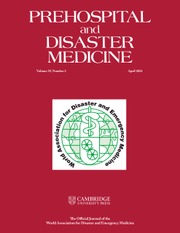No CrossRef data available.
Article contents
Review of Powered, Safe Patient-Handling Equipment for Emergency Medical Services via an Insurance Safety Intervention Grant Program
Published online by Cambridge University Press: 15 April 2025
Abstract
Powered equipment for patient handling was designed to alleviate Emergency Medical Service (EMS) clinician injuries while lifting patients. This project evaluated the organizational rationale for purchasing powered equipment and the outcomes from equipment use.
This project analyzed secondary data obtained via an insurance Safety Intervention Grant (SIG) program in Ohio USA. These data were primarily in reports from EMS organizations. Investigators applied a mixed-methods approach, analyzing quantitative data from 297 grants and qualitative data from a sample of 64 grants. Analysts abstracted data related to: work-related injuries or risk of musculoskeletal-disorders (MSD), employee feedback regarding acceptance or rejection, and impact on quality, productivity, staffing, and cost.
A total of $16.67 million (2018 adjusted USD) was spent from 2005 through 2018 for powered cots, powered loading systems, powered stair chairs, and non-patient handling equipment (eg, chest compression system, powered roller). Organizations purchased equipment to accommodate staff demographics (height, age, sex) and patient characteristics (weight, impairments). Grantees were fire departments (n = 254) and public (n = 19) and private (n = 24) EMS organizations consisting of career (45%), volunteer (20%), and a combination of career and volunteer (35%) staff. Powered equipment reduced reported musculoskeletal injuries, and organizations reported it improved EMS clinicians’ safety. Organization feedback was mostly positive, and no organization indicated outright rejection of the purchased equipment. Analyst-identified design advantages for powered cots included increased patient weight capacity and hydraulic features, but the greater weight of the powered cot was a disadvantage. The locking mechanism to hold the cot during transportation was reported as an advantage, but it was a disadvantage for older cots without a compatibility conversion kit. Around one-half of organizations described a positive impact on quality of care and patient safety resulting from the new equipment.
Overall, organizations reported improved EMS clinicians’ safety but noted that not all safety concerns were addressed by the new equipment.
- Type
- Original Research
- Information
- Creative Commons
- This is a work of the US Government and is not subject to copyright protection within the United States. Published by Cambridge University Press on behalf of World Association for Disaster and Emergency Medicine.
- Copyright
- © Center for Disease Control and Prevention, 2025.



